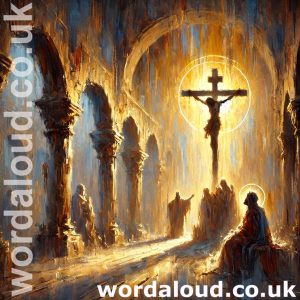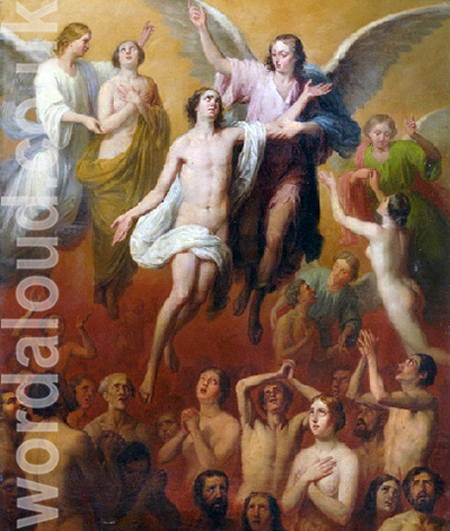Christian Art | Jesus Is Crucified | Destroy This Temple And In Three Days I Shall Raise It Up
Office Of Readings | Week 22, Wednesday, Ordinary Time | A Reading From The Commentary Of Origen On Saint John’s Gospel | Christ Spoke Of The Temple Of His Body
‘Christ spoke of the temple of his body.’
Origen’s reflection on Jesus’ words in John’s Gospel, ‘Destroy this temple and in three days I will raise it up,’ (John 2:19) draws together several layers of meaning. At the literal level, Jesus refers to the temple in Jerusalem, a central symbol of Israel’s covenant with God. Yet Origen, following John’s own interpretation (John 2:21), sees that Jesus is ultimately speaking of his own body, which would be destroyed in death and raised in resurrection.
Origen goes further by linking both temple and body with the Church. Scripture describes the Church as both the body of Christ (1 Corinthians 12:27) and as a spiritual temple (1 Peter 2:5; Ephesians 2:19–22). This dual imagery highlights the unity of Christ with his people: what happens to the Lord’s body in history prefigures the experience of his body, the Church, through time.
The scattering of Jesus Christ’s ‘bones,’ drawn from Psalm 22(21), is interpreted as the divisions, persecutions, and apostasies that afflict the faithful. Yet Origen insists that this disintegration is not final. Just as the temple of Jesus Christ’s own body was raised on the third day, so too the whole body of the Church will be restored in the resurrection. The ‘third day’ becomes an image not only of Easter but also of the consummation of all things – the dawn of the new heaven and new earth (Revelation 21:1).
Paul’s theology undergirds Origen’s exposition. The apostle teaches that believers are crucified with Christ (Galatians 6:14), buried with him (Romans 6:4), and raised with him (Colossians 3:1). Thus, the mystery of Christ’s death and resurrection is not confined to him alone but is shared with all who belong to him. For Origen, this is both promise and exhortation: Christians are called to endure suffering with Christ, confident that participation in his cross leads to participation in his risen life.

A Reading From The Commentary Of Origen On Saint John’s Gospel | Christ Spoke Of The Temple Of His Body
It seems to me that Jesus meant the Jews in this episode to stand for sensual men and those desirous of carnal and sensual things. These Jews were angry at his expulsion of the people who were turning his Father’s house into a market. So they asked for a sign to justify these actions, a sign that would show that the Word of God, whom they refused to accept, was acting rightly. The Saviour’s reply combines a statement about the temple with a prophecy about his own body, for in answer to their question: What sign can you give to justify your conduct? he says: Destroy this temple and in three days I will raise it up.
Indeed, I think that both the temple and the body of Jesus can be seen together as a type of the Church. For the Church is being built out of living stones; it is in process of becoming a spiritual dwelling for a holy priesthood, raised on the foundations of apostles and prophets, with Christ as its chief cornerstone. Hence it bears the name ‘temple.’ On the other hand, it is written: You are the body of Christ, and individually members of it. Thus even the harmonious alignment of the stones should seem to be destroyed and fragmented and, as described in the twenty-first psalm, all the bones which go to make up Christ’s body should seem to be scattered by insidious attacks in persecutions or times of trouble, or by those who in days of persecution undermine the unity of the temple, nevertheless the temple will be rebuilt and the body will rise again on the third day, after the day of evil which threatens it and the day of consummation which follows. For the third day will dawn upon a new heaven and a new earth when these bones that form the whole house of Israel are raised up on that great day of the Lord, when death has been defeated. So the resurrection of Christ, accomplished after his suffering on the cross, embraces the mystery of the resurrection of his whole body.
For just as that physical body of Christ was crucified and buried, and afterward raised up, so in the same way the whole body of Christ’s holy ones has been crucified and lives no longer with its own life. For each of them, like Paul, makes his boast of nothing else but the cross of our Lord Jesus Christ, by which he has himself been crucified to the world, and the world to him. But each Christian has not only been crucified with Christ and crucified to the world; he has been buried with Christ too, as Paul tells us: We have been buried with Christ. But as though already in possession of some pledge of the resurrection, Paul goes on to say: And we have risen with him.
Christian Prayer With Jesus Christ
Lord Jesus Christ, you are the true temple, destroyed and raised on the third day.
Make us living stones in your body, the Church, united in faith and love.
In times of trial, keep us steadfast,
that sharing in your cross we may also share in your resurrection.
You live and reign with the Father and the Holy Spirit, one God, forever and ever. Amen.
Glossary Of Christian Terms
Temple – The sanctuary in Jerusalem, the centre of Jewish worship; in Christian interpretation, a figure of Christ’s body and the Church.
Living stones – A phrase from 1 Peter 2:5 describing believers as the material of God’s spiritual dwelling.
Cornerstone – The foundational stone in a building, used here of Christ (Ephesians 2:20).
Psalm 22(21) – A psalm of lament traditionally linked to Christ’s passion (‘all my bones are out of joint’).
Third day – Refers to Christ’s resurrection (Luke 24:7); also symbolises the final renewal of creation.
Consummation – The completion of God’s plan at the end of time.
Buried with Christ – Pauline imagery (Romans 6:4) of baptism, by which believers participate in Christ’s death and resurrection.








